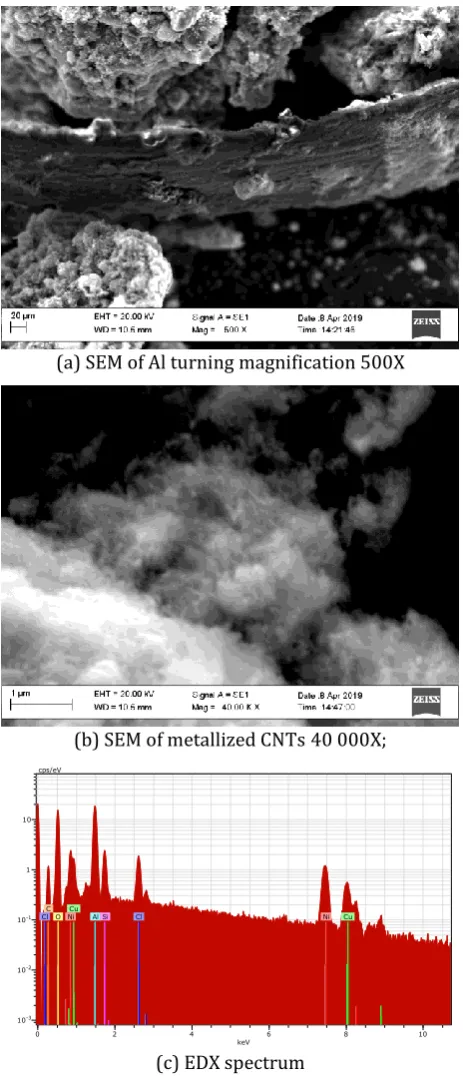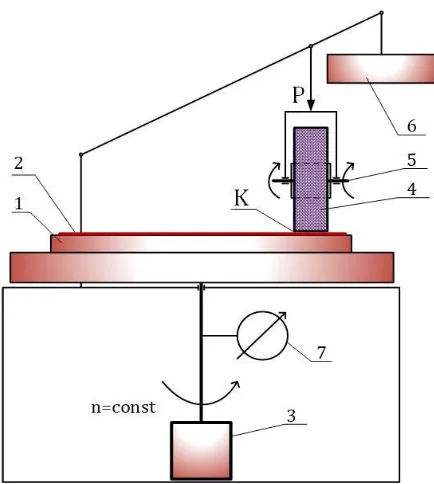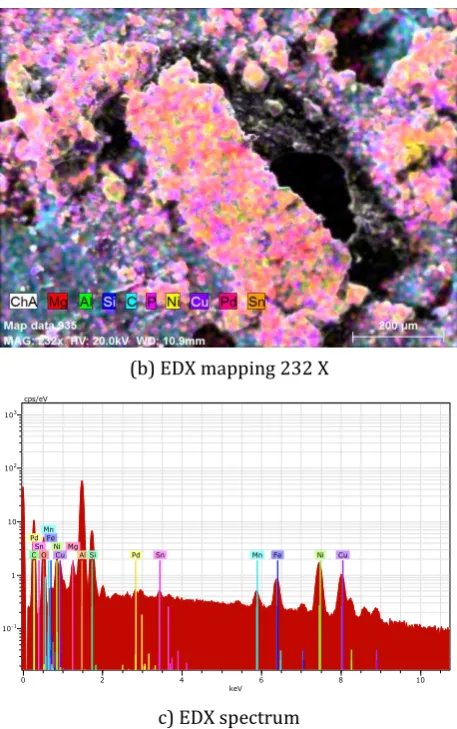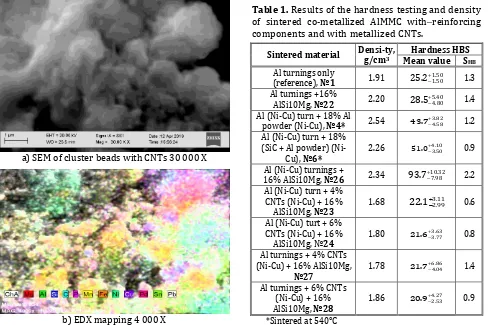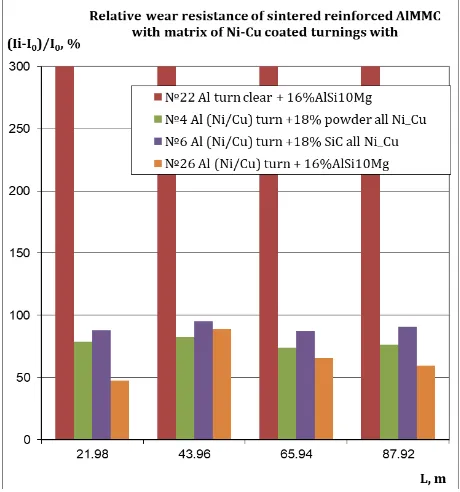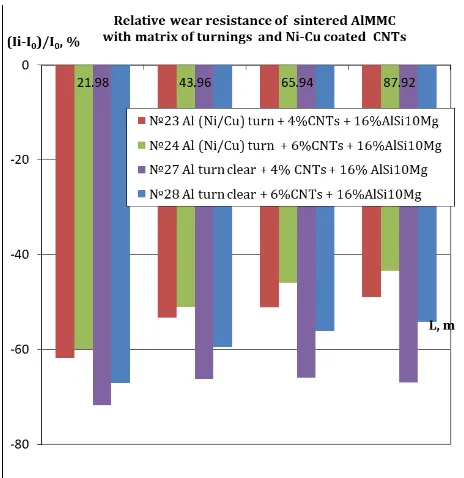Tribology in Industry
www.tribology.rsElectroless Nickel Copper Metallization as a
Reinforcing Approach for Sintered Aluminium
Metal Matrix Composites
V. Kamburov
a, R. Dimitrova
a, A. Nikolov
a, M. Kandeva
a, S. Valkanov
aaTechnical University of Sofia, 8 Kl. Ohridsky Blvd., 1000 Sofia, Bulgaria.
Keywords:
Aluminium Metal Matrix Composites Electroless Metallization
Tribology Wear Resistance Sintering CNTs
A B S T R A C T
The aim of the paper is to study a creation of co-metallized Aluminium Metal Matrix Composites based on aluminium turnings as metal matrix, aluminium powder and carbon nanotubes.
The AlMMC is composed of aluminium alloy (AlSi9Cu3) turnings, silicon carbide microparticles (SiCp) and carbon nanotubes (CNTs) after electroless (Ni-Cu-P) metallization, sintered together in different combinations with aluminium alloy powder (AlSi10Mg).
The obtained composite materials with electroless metallized components (Ni-Cu-P) were investigated performing analysis of the morphology, hardness and tribological tests. The properties of co-metalized metal-metal and metal-metal-carbon nanotubes sintered aluminium matrix composites were analysed and compared.
© 2019 Published by Faculty of Engineering Corresponding author:
V. Kamburov
Technical University of Sofia, Bulgaria.
E-mail: vvk@tu-sofia.bg
1. INTRODUCTION
Aluminium Metal Matrix Composites (AlMMC) combine the ductility and toughness of metals with the strength, hardness and wear resistance of the reinforcing phases. They offer significant potential for use in the automotive and aviation industry that require light weight, high specific strength coupled with the improved wear resistance [1,2]. The aluminium matrix of most of the structural composites is based on wrought or cast alloy composition containing Cu, Mn, Mg or/and Si and relatively rarely Zn [3,4].
Carbon nanotubes (CNTs) are a suitable material for the production of Aluminium Metal Matrix
Composites by conventional methods of powder metallurgy, e.g. hot pressing, hot extrusion, etc. [5]. Unlike polymer composites, which have been widely investigated, incorporation of carbon nanotubes (CNTs) in metal composites with metal matrix is straitened by their different nature, dispersion and high temperature processing [6]. The agglomeration and disintegration of CNTs during the processing are challenges that inhibit the development of metal matrix composites [7].
SNCNTs usually form bundle structure and are organized in crystal-like construction. Carbon nanotubes have the sp2 bonds between the
individual carbon atoms, because of which they
R
ES
EA
R
have a high tensile strength (>30 GPa) and a high elastic modulus (>1 TPa) [8].
But the CNTs could perform the function of the un-reinforcing phase compared to ceramic particles in case that hardness and wear resistance are taken into account [9]. To improve the compression strength of the CNTs during the sintering, wetting in the presence of a liquid phase, and to avoid formation of brittle Al4C3 phase, electroless
metallization is often applied [10,11].
The purpose of the work is to investigate the possibility of creation an Aluminium Metal Matrix Composites based on aluminium turnings with aluminium powder as metal matrix with reinforcing, neutral and un-reinforcing electroless metallized components. Aluminium alloy turnings (AlSi8Cu3), aluminium alloy powder (AlSi10Mg), silicon carbide particles (SiCp) and carbon nanotubes (CNTs) are used to create AlMMC with сo-metallized components.
2. MATERIAL AND METHODS
A cast aluminium alloy (EN AB-AlSi8Cu3) is used to produce the aluminium turnings with cross-sectional dimensions of about 0.1 mm x 0.05 mm. The mechanical properties of the basic aluminium alloy EN AB-46200 (DIN 226) are as follows: Brinell hardness 82; yield strength Rp0.2
= 130 MPa; ultimate tensile strength Rm =
210 Mpa; with density 2.8 g/cm3, melting onset
(Solidus) 540OC, melting completion (Liquidus)
620OC. A SLM aluminium alloy powder (LPW
AlSi10Mg) with size of about 20-63 m is used as a neutral additive phase for sintering.
The pure aluminium powder is used for neutral additive with size of max. 100 m, stabilized with 2% fat, 90% base substance. The silicon carbide particles (SiCp) are used as a reinforcing additive with size of 7-10 μm mixed with Al powder (1:1). The singlewall carbon nanotubes (CNTs) had an average diameter of 10-40 nm and a length of 1.0-25 m, a purity by weight 93% and a specific surface area 150–250 m2/g.
2.1Electroless Ni-Cu-P of the Components
After surface preparation the reinforcing and un-reinforcing components for AlMMC are chemically nickel-copper coated.
The solution for electroless ultrasonic treatment for realization of the Ni–Cu-P coating procedure [12, 13] contains, as follows: nickel chloride (NiCl2.6H2O) - 25-40 g/l; copper sulphate
(NiSO4.6H2O) – 10-25 g/l; ammonium citrate
(NH4)2C6H6O7.H2O - 50-80 g/l; sodium citrate
(Nа3C6H5O7.2H2O) - 30-50 g/l; and sodium
hypophosphate (NaH2PO2.Н2О) - 10-20 g/l.
The preparation of CNTs includes surface cleaning in acetone (СН3СОСН3) and surface
modification containing the following stages: oxidization in concentrated nitric acid (HNO3);
sensibilization and chemical activation in solution, containing PdCl2 and SnCl2.
The degreased aluminium turnings (AlSi8Cu3) are treated with an acid solution of 2 ml HF 4 and 4 ml HNO3 in 400 ml distillated water.
The result from the fiber modification and the removal of the oxide layer from the aluminium turnings is the creation of a low pH at the dispersion phase surface and accordingly the reduction of the total pH of the suspension.
After electromagnetic stirring the suspension for the plating, along with the activated aluminium turnings / CNTs has a pH value of 5.
The suspension is alkalized with ammonia to pH 9-10 under ultrasonic treatment. The alkalysis of the suspension with ammonia results in a gradual initiation of an exothermic reaction at room temperature resulting in an intense release of hydrogen in the form of bubbles. This reaction is maintained by the treatment in an ultrasonic bath without the need for further heating of the suspension.
Activated turnings are metallized separately or are added to the carbon nanotubes suspension with a started release of hydrogen. After the completion of the metallization, the suspension is colored in black due to the deposited nickel-copper-phosphorous coating on the Al turnings.
After the completion of the co-nickel-copper metallization of the disperse phase and the aluminium turnings, they are filtered.
500X magnification (Fig. 1a). The structure and the morphology of filaments of metallized carbon nanotubes are visible on scanning electron microscopy at a sufficiently large magnification of 40 000X (Fig. 1b).
(a) SEM of Al turning magnification 500X
(b) SEM of metallized CNTs 40 000X;
0 2 4 6 8 10
keV 10-3
10-2
10-1
1 10
cps/eV
Ni Ni Cu Cl Cu Cl C O Al Si
(c) EDX spectrum
Fig. 1. Co-metallized (NI-Cu-P) aluminium alloy (AlSi8Cu3) turnings and CNTs.
From the Energy Dispersive X-ray (EDX) analysis shown in Fig. 1c it can be seen that when co-metallization with the described
ultrasonic treatment solution, the nickel and copper peaks are almost equal, which implies the coating of sintering components with a copper-nickel based alloy.
2.2Sintering of Aluminium Metal Matrix Composites
The production of samples for hardness and wear resistance testing from the co-metallized dispersed phase and aluminium alloy turnings involves several major steps: blending with AlSi10Mg powder, cold compaction at 300 MPa, and sintering at 540-560 °C for 4 hours in an argon atmosphere. This heating results in a swelling effect and the emergence of fine drops of molten metal on the surface of the samples (Fig. 2a) due to the formation of small amounts of the supersolidus liquid phase from the basic metal alloy matrix.
The results from the SEM observation of fractured surepsolids droplet from AlMMC are shown in Fig. 2b. The EDX microanalysis shows presence of the elements: 77% Al, 12% Si, 6% Cu and 4% Ni (Fig. 2c).
(a) Sintered AlMMC with 4 % CNTs (left) and with 8 % CNTs (right)
(c) EDX mapping of the fractured eutectic droplet Fig. 2. Sintered AlMMC with matrix of Al turnings and AlSi10Mg powder.
SWCNTs are strong but they are not brittle and are capable to spring back after their exposure to compressive forces during the cold compaction. This elastic deformation effect of the compacted green composites could be neutralized by limiting volume expansion when using closed die during the heating and obtaining of the liquid phase.
After the sintering, cooling of air and age hardening is also performed at a temperature of 140-170OC for 10-14 hours.
The sintering material is a matrix of the aluminium alloy turnings (metallized or with only modificated surface) and AlSi10Mg powder of up to 16 % by weight. Before the cold compaction, about 1 % lubricant Zn stearate is added to the metallized mixture and homogenized by an intensive agitation.
The samples for wear resistance and hardness testing are rings with an inside diameter of 23 mm, an outer diameter of 42 mm and a height of 10 mm. The sintered composites have a different color (Fig. 2) and different densities because of the different metalized CNTs content.
The Brinell hardness is conducted according to ISO 6506-1: 2014 with two load types 24.52 N and 49.03 N at a 1 mm diameter steel ball on the Zwick 4350, Germany.
The tests of the AlMMC tribological parameters were performed on the tribometer with a “disc-roll” contact geometry (Fig. 3).
Fig. 3. The scheme of “disc-roll” tribometer.
The test specimen 4 forms a contact (K) with an abrasive surface 2, which is disposed on a horizontal disk 1. The disc 1 rotates around its central vertical axis with a constant frequency n, which is supplied by an electric motor 3. The number of revolutions (N) is measured by cyclometer 7.
The test specimen 4 is a disc that rotates freely about a horizontal axis 5. The axes of rotation of the disk 1 and of the sample 4 are two cross axes. An abrasive wear on the cylindrical surface of the specimen occurs in the contact surface (K). The contact load (P) is provided by weight 6 on the axis 5. The test specimen 4 has the following dimensions: outer diameter Ø 43 mm inside diameter Ø 23.5 mm and contact width 10 mm. The nominal contact area between the abrasive surface and the sample is about 10 mm2. The linear sliding speed of the center of
gravity of the contact surface is 0.239 m/s.
N
S2 (1)
where: r = 35 mm is the distance between the rotational axis of disc sample and mass centre of the contact area, and N is the number of abrasion cycles.
The wear resistance I is calculated according to the formula:
m / S A .
I a (2)
where: ρ is the density of the composite material, Aa - the nominal contact surface, and m - the measured mass wear.
3. TESTING AND RESULTS
3.1 Morphology and Structure of the AlMM Composites
Results from SEM of sintered co-metallized AlMMC with 16% by weight of AlSi10Mg powder are shown in Figure 4. The photos show the deformed during cold compression aluminium chip and sintered AlSi10Mg powder (Fig. 4a). The EDX mapping shows the presence of the elements Ni and Cu on the turning (Figs. 4b and 4c), which prove the committed Ni-Cu coating.
Results from SEM of fracture of sintered co-metallized AlMMC with 18 % silicon carbide and aluminium powder in a ratio of (1:1) are shown in Fig. 5. The silicon carbide particles with their typical sharp edges located in the aluminium alloy matrix are clearly shown (Fig. 5a). The EDX microanalysis shows the presence of the elements Ni and Cu (Figs. 5b and 5c), which prove the committed nickel-copper coating.
a) SEM of deformed Al turning 207 X
(b) EDX mapping 232 X
0 2 4 6 8 10
keV 10-1
1 10 102
103
cps/eV
Al Si Cu Cu
Mg
Ni Ni
O
C Fe
Fe
Mn Mn
Sn Sn
Sn
Pd Pd
Pd
c) EDX spectrum
Fig. 4. Sintered AlMMC with metallized Al (NI-Cu-P) turnings and 16 % AlSi10Mg powder.
Results from SEM of fracture of sintered co-metallized AlMMC with 8 % carbon nanotubes are shown in Fig. 6. The metallized CNTs in the aluminium matrix can be distinguished only at large magnitudes from 30 000 to 50 000 times. The individual nanotubes can be distinguished in cluster beads after SEM analyses (Fig. 6a).
(b) EDX mapping 5000 X
0 2 4 6 8 10
keV 10-2 10-1 1 10 102 cps/eV
C O Fe Ni Cu Al Si Fe Ni Cu Zn Zn
(c) EDX spectrum
Fig. 5. Sintered co-metallized (NI-Cu-P) AlMMC with 18 % SiC and Al powder.
a) SEM of cluster beads with CNTs 30 000 X
b) EDX mapping 4 000 X
0 2 4 6 8 10
keV 10-1 1 10 102 103 cps/eV
Al Si Cu Cu Mg Ni Ni
O
C Fe
Fe Mn Mn Sn Sn Sn Pd Pd Pd P
(c) EDX spectrum
Fig. 6. Sintered co-metallized (NI-Cu-P) AlMMC with 8 % CNTs and 16% AlSi10Mg
Those clusters are shown as separate entities with smaller magnification. The EDX microanalysis shows the presence of the elements Al, Si, C, Mg, P, Ni, Cu, etc. (Figs. 6b and 6c).
3.2 Results from AlMM Composites Hardness
Table 1 shows the results from the density determination and the hardness testing (mean values and standard deviation SHB) of the
sintered co-metallized AlMMC composites with different type and quantity of neutral, reinforcing and un-reinforcing components.
Table 1. Results of the hardness testing and density of sintered co-metallized AlMMC with reinforcing components and with metallized CNTs.
Sintered material Densi-ty, g/cm3 Hardness HBS Mean value SHB
Al turnings only
(reference), №1 1.91 25.211..5050 1.3 Al turnings +16%
AlSi10Mg, №22 2.20 28.554..4080 1.4 Al (Ni-Cu) turn + 18% Al
powder (Ni-Cu), №4* 2.54 43.734..8258 1.2 Al (Ni-Cu) turn + 18%
(SiC + Al powder)
(Ni-Cu), №6* 2.26
10 . 4 50 . 3 0 . 51 0.9
Al (Ni-Cu) turnings +
16% AlSi10Mg, №26 2.34 93.7107.98.32 2.2 Al (Ni-Cu) turn + 4%
CNTs (Ni-Cu) + 16%
AlSi10Mg, №23 1.68
11 . 3 99 . 2 1 . 22 0.6
Al (Ni-Cu) turt + 6% CNTs (Ni-Cu) + 16%
AlSi10Mg, №24 1.80
63 . 3 77 . 3 6 . 21 0.8
Al turnings + 4% CNTs (Ni-Cu) + 16% AlSi10Mg,
№27 1.78 86 . 6 04 . 4 7 . 21 1.4
Al turnings + 6% CNTs (Ni-Cu) + 16%
AlSi10Mg, №28 1.86
27 . 4 53 . 2 9 . 20 0.9
The density and the hardness of sintered co-metallized AlMMC composites depends on the type and the percentage of the metallised dispersed phase and co-metallization level of its components (Table 1).
Insertting the neutral AlSi10Mg or Al powder to the aluminium turnings improves the interfacial bonding in the sintered composite. Adding only AlSi10Mg powder to turnings insignificantly increases the density and the hardness. Inserting the ceramic metallized reinforcing components (SiCp and Al powder) and co-metallization of all components increase almost twice the hardness even at lower sintering temperature of 540 OC.
The metallization of aluminium turnings at 540
OC without additives leads to insignificant
increase in the hardness, but this approach for Ni-Cu-P coating of alumimium matrix components with addition of AlSi10Mg particles and sintering at higher temperature (560 OC)
increases the hardness over three times.
Lowest values of the hardness and the density is accounted in the sintered AlMMC with CNTs. The co-metallizаtion of all components does not shift their mechanical parameters.
The comparison with other composites and their behavior during the wear resistance and hardness test shows that the Ni-Cu coated CNTs to a large extent preserved their original structure in the aluminium alloy matrix after sintering and they retain their initially high elastic properties.
3.3 Results from AlMM Composites Tribological Properties
For a reference sample is selected a sintered material only from aluminium turnings without coating or any additional components (a dotted line).
On the graphs of Figure 7 there are shown the results from the determination of the wear resistance of sintered AlMMC composites with matrix of Ni-Cu coated alumimium turnings.
The highest wear resistance (Fig. 7) was demonstrated by the sintered at 560 OC AlMMC
with matrix of turnings with 16 % AlSi10Mg powder. They have an increased wear resistance by about 3-4 times compared to the reference sample of only aluminium turnings.
Fig. 7. Variations of abrasive wear resistance of reinforced AlMMC with Ni-Cu-P coated turnings.
The metal-metal composites with matrix of metallized Al turnings demonstrate increased by 60-90 % wear resistance compared to the reference sample, which is almost equal to the ceramic reinforced AlMMC with SiCp (Fig. 8).
Fig. 8. Relative wear resistance change of reinforced AlMMC with Ni-Cu coated turnings.
resistance compared to the reference sample. Figure 8 also shows that the co-metallized AlMMC with reinforcing components (SiC and Al powder) have 80-95 % increase in their wear resistance. On the Fig. 8 is also visible that the AlMMC with metallized (Ni-Cu) turnings matrix have 60-90 % increase in their wear resistance.
Fig. 9. Variations of abrasive wear resistance of AlMMC specimens AlMMC specimens with AlSi10Mg powder and metallized (Ni-Cu) CNTs.
On the graphs of Fig. 9 there are shown the results from the determination of the wear resistance of sintered at 560 OC AlMMC
composites with AlSi10Mg powder and Ni-Cu coated CNTs. Despite the use of AlSi10Mg powder, which improves the interfacial bonding, all sintered AlMMC with matrix of Аl turnings with metallized CNTs demonstrate low wear resistance (Fig. 9). Furthermore the increase in their percentage ratio over 8 % results in an instability and a disintegration of the sintered (at 540 OC and 560 OC) composites.
The behavior of the sintered co-metallized AlMMC un-reinforced with CNTs shows, that due to the metallization, they have retained their structure and elastic properties after sintering.
On Fig. 10 the sintered AlMMC composites with metallized CNTs are compared to the reference sample in regard to their relative abrasion wear resistance.
Fig. 10. Relative wear resistance change of AlMMC specimens AlMMC specimens with AlSi10Mg powder and metallized (Ni-Cu-P) CNTs.
It can be seen from Fig. 10 that the AlMMC with matrix of turnings and metallized CNTs have a 50-70 % decrease in their wear resistance. The evaluation of this behavior, determination of their friction coefficient and finding more suitable sintering modes are a subject to future research on improving the mechanical behavior of those sintered AlMMC with CNTs.
4. CONCLUSIONS
1. It has been found that the addition of a neutral phase (AlSi10Mg or pure Al powder) with another fractional composition to the aluminium turnings significantly improves the interfacial bonding, hardness and the wear resistance of the sintered AlMMC. 2. The metallization (Ni-Cu) of matrix
aluminium turnings as a reinforcement approach for sintered AlMMC demonstrate a triple increase in hardness and a 60-90% increase of wear resistance of this metal-metal composite.
4. Sintered AlMMC composites with AlSi10Mg powder un-reinforced with metallized CNTs demonstrate the lowest density, mechanical and tribological performance. Their behavior during the tests and scanning electron microscopy shows that through to the metallization CNTs have retained their fibrous structure and high elastic properties after the cold compaction and sintering at 560 OC.
Acknowledgments
The authors would like to thank the Research and Development Sector at the Technical University of Sofia for the financial support.
REFERENCES
[1] Th. Schubert, T. Weißgärber, B. Kieback, H. Balzer, H.C. Neubing, U. Baum, R. Braun, P/M Aluminium Structural Parts for Automotive Application, Powder Metallurgy World Congress and Exhibition, 17-21 October, 2004, PM2004, Vienna, Austria, vol. 5, pp. 627-632.
[2] A. Pohl, High Wear Resistance Parts of Sintered Aluminium for the Automotive Application, in Powder Metallurgy Congress and Exhibition, 2-5 October, 2005, PM2005, Prague, Czech republic, vol. 2, pp. 199-204.
[3] M. Babic, S. Mitrovic, I. Bobic, Tribological properties of composites with substrate made of ZA-27 alloy reinforced by the graphite particles, Tribology in Industry, vol. 29, No 3&4, pp. 3-8, 2007.
[4] S. Mitrovic, M. Babic, B. Stojanovic, N. Miloradovic,
Tribological Potencial of Hybrid Composites Based on Zinc and Alluminium Alloys Reinforced with SiC and Graphite Particles, in 12th International Conference on Tribology, 11-13 May, 2011, SERBIATRIB 11, Kragujevac, Serbia, Serbian Tribology Society, pp. 138-145.
[5] A. Agarwal, S. Bakshi, D. Lahiri, Carbon nanotubes: Reinforced metal matrix composites.
Boka Raton: CRC Press Taylor & Francis group, 2011, doi: 10.1201/b10281
[6] A. Yarahmadi, M Rajabi, M. Noghani, R. Taghiabadi,
Syntesis of Aluminium-CNTs composites using double-pressing double-sintering method (DPDS), J. Nanostruct, vol. 9, iss. 1, pp. 94-102, 2019, doi: 10.22052/JNS.2019.01.10
[7] J. Liao, M.-J. Tan, Mixing of carbon nanotubes (CNTs) and aluminium powder for powder metallurgy use, Powder Technology, vol. 208, iss. 1, pp. 42-48, 2011, doi: 10.1016/j.powtec.2010.12.001
[8] V.N. Popov, Carbon nanotubes: properties and application, Materials Science and Engineering: R: Reports, vol. 43, iss. 3, pp. 61-102, 2004, doi: 10.1016/j.mser.2003.10.001
[9] V. Kamburov, R. Dimitrova, M. Kandeva, A. Mihaylov, Aluminium metal matrix composite sintering with electroless metallized components, in 16th International Conference on Tribology,
15-17 May, 2019, SerbiaTrib’19, Kragujevac, Proceedings on Engineering Sciences, vol. 1, no. 1, pp. 124-132.
[10]R. Dimitrova, M. Kandeva, V. Kamburov, M. Jordanov, Mechanical and tribological characteristics of hardfaced dispersive reinforced aluminium metal matrix layers, Journal of the Balkan Tribological Association, vol. 23, iss. 4, pp. 641-652, 2017.
[11] M. Kandeva, V. Kamburov, E. Zadorozhnaya, Zh. Kalitchin, Abrasion Wear of Electroless Nickel Composite Coatings Modified with Boron Nitride Nanoparticles, Journal of Environmental Protection and Ecology, vol. 19, iss. 4, pp. 1690-1703, 2018. [12]R. Dimitrova, Еlectroless nickel coatings on
silicon carbide particles using two nickel salts in alkaline solution, in 8th International Working
Conference ’’TQM – Advanced and Intelligent Approaches’’, 2-5 June, 2015, Belgrade, Serbia. [13] V. Kamburov, R. Dimitrova, K. Nikolov, Electroless
